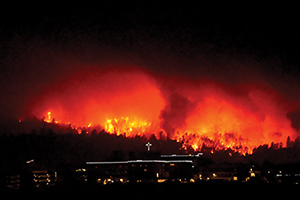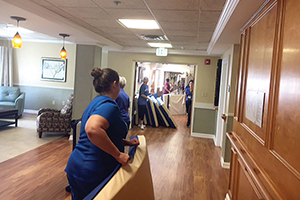By JULIE MINDA

The Carr fire crests a hilltop less than a half mile from Dignity Health’s Mercy Medical Center in Redding, Calif., on July 26. The hospital remained open throughout the fire, though it evacuated six babies from the neonatal intensive care unit, and cancelled elective surgeries. As Catholic Health World went to press, a hospital spokesperson said the fire risk to the hospital had ended.
Photo by Renae Tolbert
Since late July, a wildfire has raged near Redding in northern California, and it still was only about 50 percent contained by early August. The New York Times said it already had claimed seven lives. And, according to the California Department of Forestry and Fire Protection, by Aug. 8 it had consumed about 173,000 acres and destroyed more than 1,000 homes. Despite personal property losses, dozens of clinicians and staff at Dignity Health North State Service Area health care facilities were continuing to come to work, providing care to fire victims and other patients.
An AccuWeather forecaster predicted continued weather conditions conducive to wildfire in California into the fall. The forecaster said the fall also could bring flash flooding to the mid-Atlantic and southeastern U.S., severe weather along the Gulf Coast and potential drought in the southern Plains.
For any locality, it's not a matter of whether disaster could strike but when, and to what degree. With the ministry's expansive presence across the U.S., it is common for Catholic health care to be involved in responding to such disasters.
To be ready to mount an effective and compassionate response in their communities, health care facilities should diligently prepare for a wide variety of scenarios and build relationships with community partners. That was a consensus of the dozen-plus disaster response experts who, as presenters, shared their learnings and insights during a two-day conference CHA hosted at CHRISTUS Health's headquarters here July 25-26. "When Disasters Strike: A Special Convening for International and Domestic Response" drew dozens of Catholic health care and social service leaders from throughout the U.S.
'Scars from disasters'
CHA convened the meeting at the prompting of its board and of the association's international outreach committee. Those groups were impressed by how Catholic health care facilities and other ministry organizations have responded to the many disasters that have hit the nation recently — and particularly last year. The groups wanted to give others in Catholic health care an opportunity to learn from the responders' experience.
Bruce Compton, CHA's senior director of international outreach, said of the presenters, "The people here have scars from disasters. Some of the disasters, we won't ever forget. And there are some that we want to forget" — because of the emotional toll they exacted.
Among the disasters the panelists had responded to were Hurricane Katrina along the Gulf Coast in August 2005; the Haiti earthquake in January 2010; the Napa, Calif., earthquake of August 2014; flooding in Peru in March 2017; Hurricane Harvey along the southeastern Texas coast in August 2017; Hurricane Irma in Florida in August and September of 2017; and Napa wildfires in October 2017.
Flexible and nimble
All panelists repeatedly stressed that while no organization can totally plan for every potential disaster, facilities should identify the disaster risks in their localities, develop thorough plans, troubleshoot those plans and continually test and refine those plans.
"Prepare, prepare, prepare," advised presenter Camille Grippon, Bon Secours Health System director of ecology and global ministries. All presenters at the convening said preparations should include forging and maintaining relationships with the partners they'll likely work with in a disaster, including other health and social service providers and government agencies at the local, regional, state and federal levels.
Presenters Dr. John Gillean, who is CHRISTUS executive vice president and chief clinical officer, and Lance Mendiola, who is CHRISTUS vice president of facilities management and construction, manned CHRISTUS' system-level temporary incident command center during Hurricane Harvey and had helped lead the system's response to prior disasters. They said to save time in a disaster, CHRISTUS annually polls clinicians to determine the individuals' willingness and readiness to be deployed on short notice to relieve overburdened staff at facilities in a disaster zone. Advanced planning ensures the system has vital equipment such as generators and supplies like food and potable water ready for transport to sites in need.

Three days before Hurricane Irma made landfall in Florida last year, staff members helped evacuate residents of Bon Secours Maria Manor Nursing & Rehabilitation Center in St. Petersburg, Fla. They moved mattresses, medical equipment and other supplies to care for residents, who spent five days at St. Petersburg’s St. Jude the Apostle Cathedral and school before the all clear was given to move back to the nursing facility.
CHRISTUS transferred highly vulnerable patients from facilities in the path of Harvey before the storm hit. Harvey unleashed torrential rains that caused widespread flooding. CHRISTUS St. Elizabeth Hospital in Beaumont and CHRISTUS St. Mary Hospital in Port Arthur successfully sheltered associates and patients and remained operational despite the city of Beaumont losing its potable water supply.
Mendiola said, "You need to stay in the bounds of your disaster plan but also be flexible and nimble." All dozen CHRISTUS hospitals along Harvey's path remained in operation during the storm and its aftermath.
Temporary quarters
Karen Reich, chief executive of Bon Secours St. Petersburg Health System, recounted the trials that system endured as it complied with a government-mandated evacuation ahead of Hurricane Irma. Three days ahead of the storm's landfall, about 150 staff members of the eldercare campus successfully transported all 310 residents and all residents' belongings and medical supplies and equipment on school buses to the new location, which was St. Petersburg's St. Jude the Apostle Cathedral and school. The staff cared for the residents there for five days and then transported them back after the "all clear."
Reich said staff adaptability, persistence and creativity saved the day when government-promised supplies never materialized, and vendor equipment didn't work properly. When their source for power generators fell through, staff scrambled to find other suppliers and secure fuel. Reich said the disaster taught her despite even the most thorough planning, facilities will need "a backup plan for the backup plan for the backup plan."
Dr. Amy Herold, vice president and chief medical officer of St. Joseph Health, Queen of the Valley Medical Center, helped lead that facility's response to Napa wildfires that last year resulted in at least 44 deaths, destroyed hundreds of thousands of acres of land, forced about 90,000 people to evacuate and left about 200 people hospitalized.
Herold spoke of residual effects of a disaster — for weeks after the wildfires, people came to the Napa hospital not only with the anticipated respiratory ailments but also because of preexisting chronic conditions that had worsened when people went without medications left behind when they fled their homes.
By invitation only
Oftentimes ministry providers are not located where a disaster has hit but wish to assist — whether domestically or internationally. Conference panelists stressed the need to have policies and procedures in place for deciding how and when to aid in a disaster, and for channeling the well-meaning intentions of ministry employees. Many said they only provide aid when invited to do so.
Susan Huber, senior vice president of governance and president of Ascension Global Mission, said when determining whether and how to respond to disasters, "We start by listening" to the people on the ground who are affected. "We listen, and we do not tell them what we think they need."
Sr. Mary Jo McGinley, RSM, executive director of Global Health Ministry, which is connected with Trinity Health, added, "We use our intuition, we listen to what was not said as well as to what was said" when asking aid agencies what victims need. For instance, perhaps accepting traveling volunteers from the U.S. would be a burden to an overseas community struggling to handle a fresh disaster.
Presenters agreed that, in the vast majority of cases, it is best to provide cash to organizations responding on the ground — in lieu of volunteers and supplies, both of which must be managed and looked after.
Do no harm
Bon Secours' Grippon, who has led the Bon Secours response to multiple overseas disasters, said that system's leadership strongly discourages well-meaning clinicians and staff from traveling to disaster sites to offer help. Experience matters, she said. There are resource costs to supporting volunteers in a disaster zone, so an individual should consider whether they will be able to deliver services under extreme duress.
"Many do not understand how chaotic a disaster zone is," she said. "Many don't understand what it's like when there's sick and wounded people all around them — what it looks like and smells like and sounds like."
If people can't handle that intensity, their "presence may inadvertently do harm in a disaster zone," Grippon said.
All the presenters emphasized that by being intentional before, during and after a disaster and by viewing a disaster holistically, ministry providers can aid disaster victims in a way that furthers the aims of Catholic health care. Panelist Carl Middleton, recently retired Catholic Health Initiatives senior vice president of ethics and theology, said that in responding to disaster in a mission-based way "we're experiencing the divine in each other.
"We're encountering the resurrected Jesus in each other and in the people we serve."
To hear a podcast recorded at the conference visit chausa.org/podcast.
Copyright © 2018 by the Catholic Health Association
of the United States
For reprint permission, contact Betty Crosby or call (314) 253-3490.